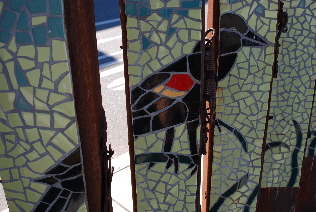I began by chosing a plate from my stash and I decided I would take photos as I chipped up the plate. It was a challenge as I have not chipped up a plate while trying to keep all the pieces in the same places as they were originally! As most of us who use plates are aware, plates are not completely flat and they have a very thick area around the bottom of the plate, which I will call it's "seat line"- the part of the plate that actually touches the table top. These are hurdles to overcome when chipping up a plate. So, I share with you my experience:
I knew that a plate with distinctive designs and pictures on it would help me when trying to keep all the pieces in order. Many people will mix in pieces from different plates- this tutorial is just how to chip up one plate and use the whole plate. TIPS: As you chip up the plate, keep it in it's original position and be careful to remember how each piece went in the "puzzle" when you pick it up to chip it. Also, take a photo of the whole plate before you begin to chip it, so you have the original to go by. I would also recommend working on a towel or large piece of cardboard so that if you have to transport your chipped up plate you can, without having to move your pieces and get them mixed up.
Step 1: Using nippers, chip the plate in half. By grabbing the opposite side than the nippers and applying pressure, it will help your crack line to go straight across.
Step 3: Now, if the center of your plate is still in tact, chip it out. If there are any "tips" on your large chunks (like if they came out more like triangles than rectangles) then chip the tips off.
Step 4: Chip the main chunks in half again!
Step 5: Now we need to begin to make our plate lie more flat by chipping along that "seat line". Do this all the way around the plate.
Step 6 (2 parts): Let's put our focus on the outer most edge layer. First chip each chunk in half once more. Then, on this particular plate, there is quite a bit of curvature (see photo). If we chip this in half width-wise, we break up that curvature and the pieces can lie more flat. Do this all the way around.
Step 7: Now we will look at, what is now, the third layer inward. These are the ones that have our "seat line" on the bottom side. We need to chip those up into smaller pieces so those lay more flat as well.
It was at this stage where I discovered my plate was just too thick to continue using my wheeled nippers. My straight edge nippers open wider so I switched to those and I was back on track!
Here is what my plate looks like now after completing step 7:
Step 8: Last step! Now chip up the middle and the pieces around the middle to be smaller. Once you have those chipped up arrange all your pieces nice and tight and you can see the resemblance to the original whole plate!
Now my plate is ready to be glued on or stuck in thinset mortar on to something! I am not sure what I will put this on...I do have a plant stand I've been wanting to mosaic...Happy chipping!



































